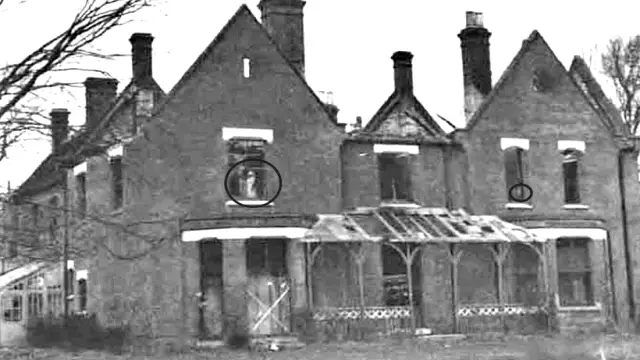Ghosts of Borley Rectory
In the early 20th century, the Borley Rectory in Essex, England, gained fame as the “most haunted house in England.” The building, known for ghost sightings, mysterious sounds, and eerie poltergeist activity, attracted hundreds of visitors, many of whom reported paranormal experiences. But how much of the haunting is true?
The Haunted History of Borley
Located in the quiet village of Borley on the Essex-Suffolk border, the rectory was built in 1862 for Reverend Henry Bull and his family. With 23 rooms and sprawling grounds, this Neo-Gothic mansion stood in stark contrast to its picturesque countryside surroundings. Local legend suggested it was built on the site of a medieval monastery, which fueled suspicions and stories of hauntings even before its completion.
The ghostly tales started with sightings of a nun, reportedly doomed to wander the grounds forever. According to legend, the nun had a forbidden romance with a monk from the monastery. When caught, the monk was hanged, and the nun was supposedly entombed alive within the monastery walls—a story that adds a dark, romantic air to Borley’s haunted reputation.
The Bull Family and Nun’s Walk
Reverend Bull, the first resident of the rectory, reportedly became fascinated by the paranormal activity, especially the sightings of the nun along a specific path in the garden, later called “Nun’s Walk.” Bull even built a summer house overlooking this path, where he and his family spent many evenings hoping to glimpse the spirit. Staff and visitors also reported strange occurrences, including faceless figures staring at them from windows and sudden, inexplicable noises that left many of them deeply disturbed.
Poltergeists and Apparitions
After Bull’s death, his son Harry took over the rectory, and sightings of the nun continued. Harry’s daughters reported trying to speak to the nun, only for her to disappear as they approached. This wasn’t the only apparition reported; a phantom coach racing towards the house and other shadowy figures were also commonly seen, both by the family and their neighbors.
The most disturbing incidents occurred during the tenure of Reverend Eric Smith, who moved into the rectory with his wife in 1929. Mrs. Smith discovered a skull wrapped in brown paper in a cupboard, and soon after, she reported hearing unexplained bells and footsteps echoing throughout the house. These incidents compelled the couple to contact the Daily Mirror, which sent Harry Price, a renowned paranormal investigator, to the rectory.
Harry Price and the Heightened Hauntings
Harry Price’s arrival intensified the hauntings. Stones, vases, and other objects were reportedly thrown at him by invisible forces. He recorded mysterious “spirit messages” tapped out from a mirror and encountered an aggressive poltergeist presence. Some skeptics, however, accused Price of faking these incidents to enhance his reputation, as he was known for performing illusions and may have had stones in his pockets to throw at opportune moments.
Despite the doubts, Price’s accounts became famous, and Borley Rectory’s reputation grew. Many were skeptical, but enough unexplained incidents occurred that the Smiths soon moved out, unable to bear the eerie activity any longer.
The Foysters’ Disturbing Experiences
The next family to inhabit Borley Rectory, Reverend Lionel Foyster and his wife Marianne, faced even more terrifying phenomena. Reports of wall writings, shattering windows, and mysterious lock-ins plagued them. The poltergeist activity seemed to target Marianne specifically, and she even claimed to have been physically attacked by unseen forces.
Foyster attempted exorcisms, and although these seemed to calm the hauntings briefly, they soon returned with greater intensity. Disturbingly, notes began appearing on the walls, imploring for “help” and “prayers.” After enduring years of relentless paranormal activity, the Foysters left the rectory.
The Final Years: Fires, Séances, and Skepticism
In 1937, Harry Price returned to lease the rectory for a full year. His goal was to conduct a comprehensive study of the paranormal occurrences. He organized a team of 48 investigators and documented various phenomena, including temperature fluctuations and apparitions. However, even within his group, doubts about Price’s methods persisted. Some accused him of embellishing his findings, noting that ghostly activity often spiked conveniently when Price or Marianne were present.
Price’s most controversial finding emerged during a séance, where a spirit claimed that a fire would destroy the rectory and reveal a buried body. In 1939, a mysterious fire broke out, leaving the rectory in ruins. While some believed it was an act of arson, the event fueled further speculation about the rectory’s haunted past.
A Legacy of Ghosts and Doubts
Following Price’s death, investigations continued, but skeptics began to debunk many of the haunting tales. Several authors published a report known as the Borley Report, concluding that natural explanations such as rats, the wind, and acoustics could account for most of the phenomena. The original legends about buried nuns and murdered monks were proven to have no historical basis, likely invented to give Borley Rectory a more gothic allure.
Still, many locals and visitors to the site claim to feel an eerie presence near the churchyard where the rectory once stood. Some even report catching glimpses of a ghostly nun or hearing faint footsteps at night, long after the rectory itself vanished.
A Haunted Legacy or Clever Hoax?
Borley Rectory’s story embodies the mysterious allure of haunted houses. While many of the hauntings may have been exaggerated or fabricated, the fascination with Borley endures. Whether a true paranormal site or a cleverly crafted ghost story, Borley Rectory remains a key piece of England’s ghostly lore, drawing curious minds to ponder the truth behind the legends.

